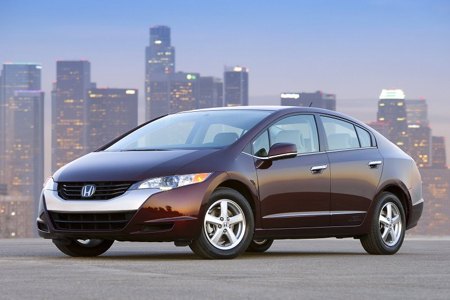Is Honda's Green Strategy Fuelish?
According to American Honda VP Dan Bonawitz, Honda is the BMOC when it comes to automotive innovation, and that includes hybrids, clean diesels and fuel cells. As EV World reports, just don't put an E in front of Honda (either automotive or pharmaceutical). The Japanese automaker's investigating various electric drive technologies and may still introduce a hybrid-electric CR-Z sports car, BUT Honda isn't impressed enough with current battery technology enough to pursue a true electric vehicle. Bonawitz would rather talk about the new, improved FCX Clarity, in which the fuel cell system and battery pack take-up no more space than a gasoline-electric hybrid power plant. Bonawitz estimates that Honda's hydrogen fuel cell vehicle is three times more efficient than an equivalent conventional gas burner and 2.5 times more efficient than a compact hybrid. He rates the Clarity's EPA combined cycle at 68 mpg with a 60 percent reduction in CO2 emissions. Bonawitz also claims that the Clarity's tank-to-wheel efficiency has been improved to 60 percent. For some reason, he glosses over the hydrogen production inefficiencies. Until that process stops being a net energy loser, the fool cell label sticks.
More by Donal Fagan


































Comments
Join the conversation
Johnson, If one were to approximate slowness with a horsepower to weight ratio or torque to weight ratio, that old Civic does look a little slow (check out the torque though), but the 95 VX doesn't. 1985 hp/wgt - .033 tq/wgt - .045 1995 .043 .046 2005 .047 .045 2007 .054 (But having driven one of these, it doesn't feel nearly this fast. Feels on par with an 05 EX) .049 2007 Fit .044 .043 Ratios like these never tell the whole story (hell, even peak horsepower and torque don't) but for the VX to be just shy of the current Fit in hp and better in tq is quite impressive.
I'm no Toyota fanboy, but what they did with the Prius deserves credit. They designed a practical car from the ground up as a Hybrid, and made it relatively affordable. I've considered one, but the goofy Corolla-like steering wheel position, and lack of a super-adjustable driver's seat has put me off a bit. And yes, the "nerd factor" is another. Still, if the next-gen is a plug-in, and addresses the driver's comfort issues, I might get one (unless someone can trump their lead in the technology). I'd love to see a "sporty" version that gives up an mpg or two (using a switch on the dash) to make it more fun to drive, but that ability might compromise the EPA rating in some way -- maybe make the "econ" mode the default every time the car is started.
FWIW, these guys think they can create hydrogen efficiently: http://www.sciencedaily.com/releases/2008/02/080217170412.htm
The National Hydrogen Association is excited about the launch of the Honda FCX Clarity. The FCX Clarity marks a positive step in moving us towards a hydrogen economy. Although the article from EV World raises some important questions about the hydrogen infrastructure, the hydrogen community is working to effectively overcome these hurdles. For instance, Honda is making progress developing a Home Energy Station to further facilitate the adoption of fuel cell applications presenting a solution to infrastructure problems by allowing the consumer to produce hydrogen at home – no need for large fueling stations. The Home Energy Station can also provide heat and electricity to a home, reducing carbon emissions by 30 percent and energy saving costs by an estimated 50 percent. While it may appear the transition to hydrogen is complicated and far into the future, organizations such as Shell, Chevron, and BP are working with the Department of Energy to establish a hydrogen fueling infrastructure. An initial $10 to $15 billion investment, equivalent to about one month of military spending in Iraq, would establish an initial refueling infrastructure within 2 miles anywhere within the top 100 metro areas. Furthermore, more than 40 billion kg of hydrogen are produced globally each year with production plants located near or within every major metropolitan city in the US – enough to fuel 130 million fuel cell-electric vehicles annually. Since hydrogen is also used to produce gasoline, switching from gas to hydrogen is simpler than it appears.